“I believe current bicycle code is too complex, too vague, and too rigid.”
– Victor Duong, project manager at LEEB architects and former PBOT Bicycle Advisory Committee member
The Portland Bureau of Transportation is under pressure to make changes to their bicycle parking requirements. It’s part of an effort by City Commissioner Carmen Rubio to respond to a recent survey that found PBOT’s bike parking code is considered by many stakeholders to major impediment to housing production.
At times during a meeting of the bureau’s Bicycle Advisory Committee Tuesday, PBOT Planner Sarah Figliozzi defended the bike parking code and sought to clarify several aspects of a recent report that shed an unfavorable light on it. But she also accepted feedback and revealed the specific parts of the code PBOT would be willing to put on the chopping block. According to Figliozzi, three possible changes are afoot: removal of requirements to build an alcove within residential units and provide spaces for large cargo bikes, as well an overall reduction in the amount of required spaces in new residential buildings.
The current code, adopted in 2020 after years of analysis and feedback, allows developers to provide 50% of long-term bike parking for each residential unit within the unit itself — as long as it is located in a closet or alcove within 15-feet of the front door. This was done to avoid the problem of architects and developers deciding to simply hang a rudimentary hook on a living room wall to fulfill their bike parking requirement. After hearing from housing regulation survey respondents (which included hundreds of developers, property owners, and city staff), that those standards are difficult to comply with, Figliozzi said they are considering a permanent removal of that requirement.

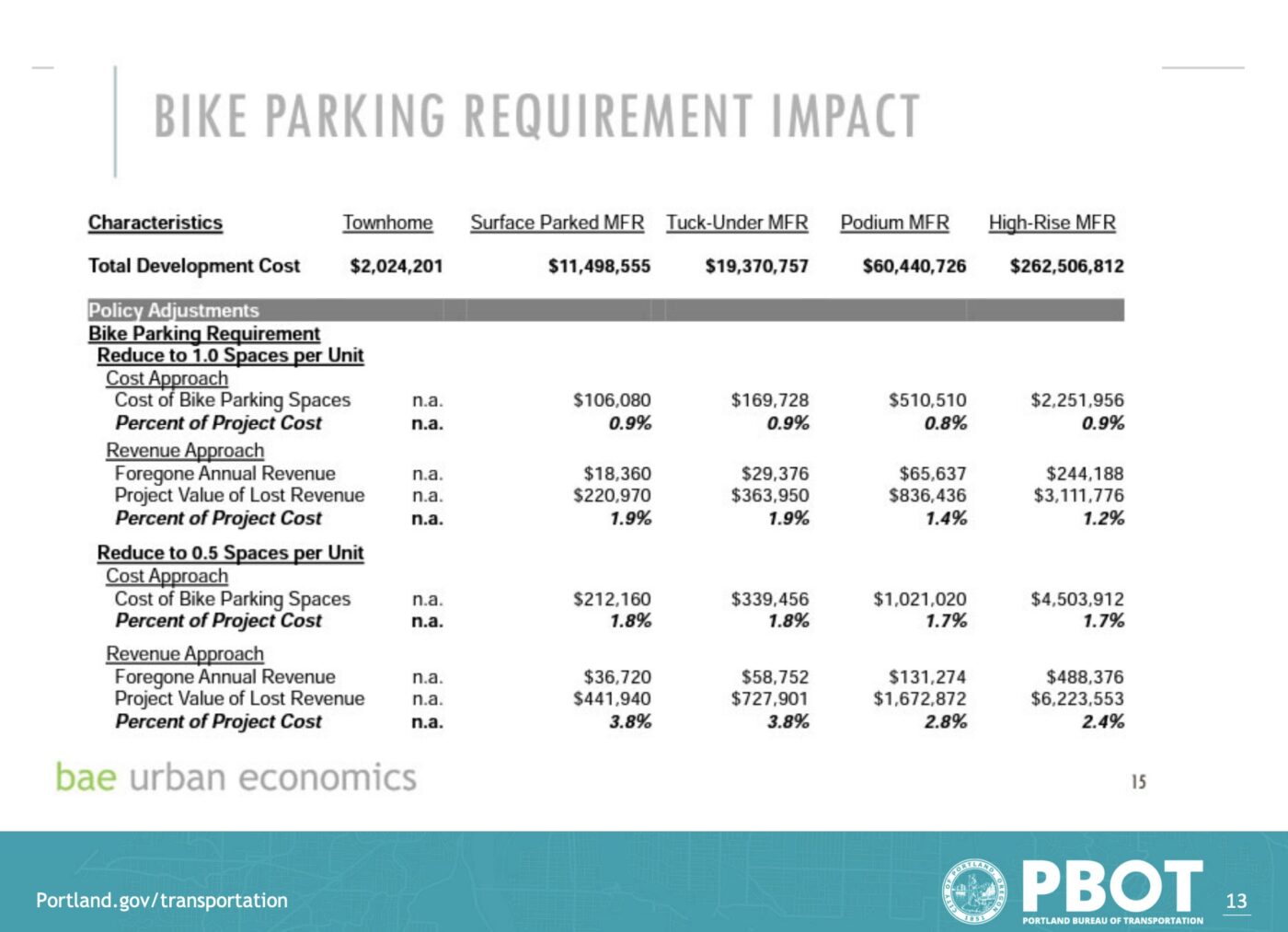

“Some of these design elements are just challenging for the applicants to configure in the types of floor plans that they’re used to working on,” Figliozzi said at the BAC meeting Tuesday. “And they take up a lot of floor space.”
Former BAC member and Portland cycling advocate Victor Duong (an invited guest at Tuesday’s meeting) is project manager at LEEB architects. He’s currently working on a 200-unit project in northwest Portland, “that is currently going through a lot of these bike parking challenges.” He shared several serious concerns in response to Figliozzi’s presentation.
“[The city permitting office] is requiring us to build a bike alcove 15-feet high and there was zero flexibility. I kid you not. A 15-foot wall is just a waste of money,” Duong said. In a follow-up email, he told BikePortland that he’s all for more bicycle parking both personally and professionally, but he believes the current code is, “Too complex, too vague, and too rigid.” He even cited an instance where permit officials from City of Portland “dinged” him for wanting to build more in-unit bike parking than was required.
Duong also said he feels the current code is “devastating” to creating affordable housing in Portland and encouraged BAC members to look at actual plan drawings as they consider the impacts of bike parking requirements. “For every 15 units, the current bike code removes one unit. So on my 200-unit project, it’s effectively removed seven units… it’s very costly.” (A figure included in a consultant’s report used by Rubio’s office of $11,000 in bike parking costs per unit has been the focus of much debate. Figliozzi said that figure is a range between $2,600 to $11,000 per unit and that the consultants have agreed to add additional context about the assumptions and analysis to their report.)
The other part of the code Figliozzi said PBOT will propose for removal is the section that requires a certain amount of spaces for larger bikes. PBOT wanted the code to reflect the growing popularity of cargo bikes in Portland and they added a provision in 2020 that 5% of spaces must be built with a 10′ by 3′ footprint. But now they’ve heard that requirement takes up too much space in smaller developments and they are recommending a temporary removal of that piece of the code.
[Related: LEED apartment building lacks cargo bike parking, so family rents an auto space]
BAC member Katherine Sheie opposed that idea. “I understand that it’s difficult to to accommodate these larger spaces,” she said. “But I think if we are going to get to a larger mode split, we need to be able to provide cargo bike parking, so that people can not own a car and still move big stuff around.”
But from an architect’s perspective, Duong said the 10 x 3 required footprint didn’t fully capture the amount of space required by that part of the code. “With the maneuvering clearances, the cargo bike requirement is two-thirds the dimensions of a compact car parking stall — and that’s inside the building envelope.”
The third part of the code Figliozzi said PBOT staff are contemplating for revision is a temporary reduction of the required amounts of parking for residential units. The current code requires a 1.5 and 1.1 bike parking space per unit minimum in the central city and outer neighborhoods, respectively. Those amounts could drop to 1 and 0.5 per unit. “Staff are continuing to talk through repercussions of temporarily reducing required amounts for residential units,” stated one of Figliozzi’s slides.
From here, PBOT, the Housing Bureau, Bureau of Planning & Sustainability (BPS) and Commissioner Rubio’s office will continue to discuss and negotiate which code changes will support more housing production. A draft of changes will be available in early fall with opportunities for public comment. A hearing on the draft at the Planning & Sustainability Commission is scheduled for October 24th.


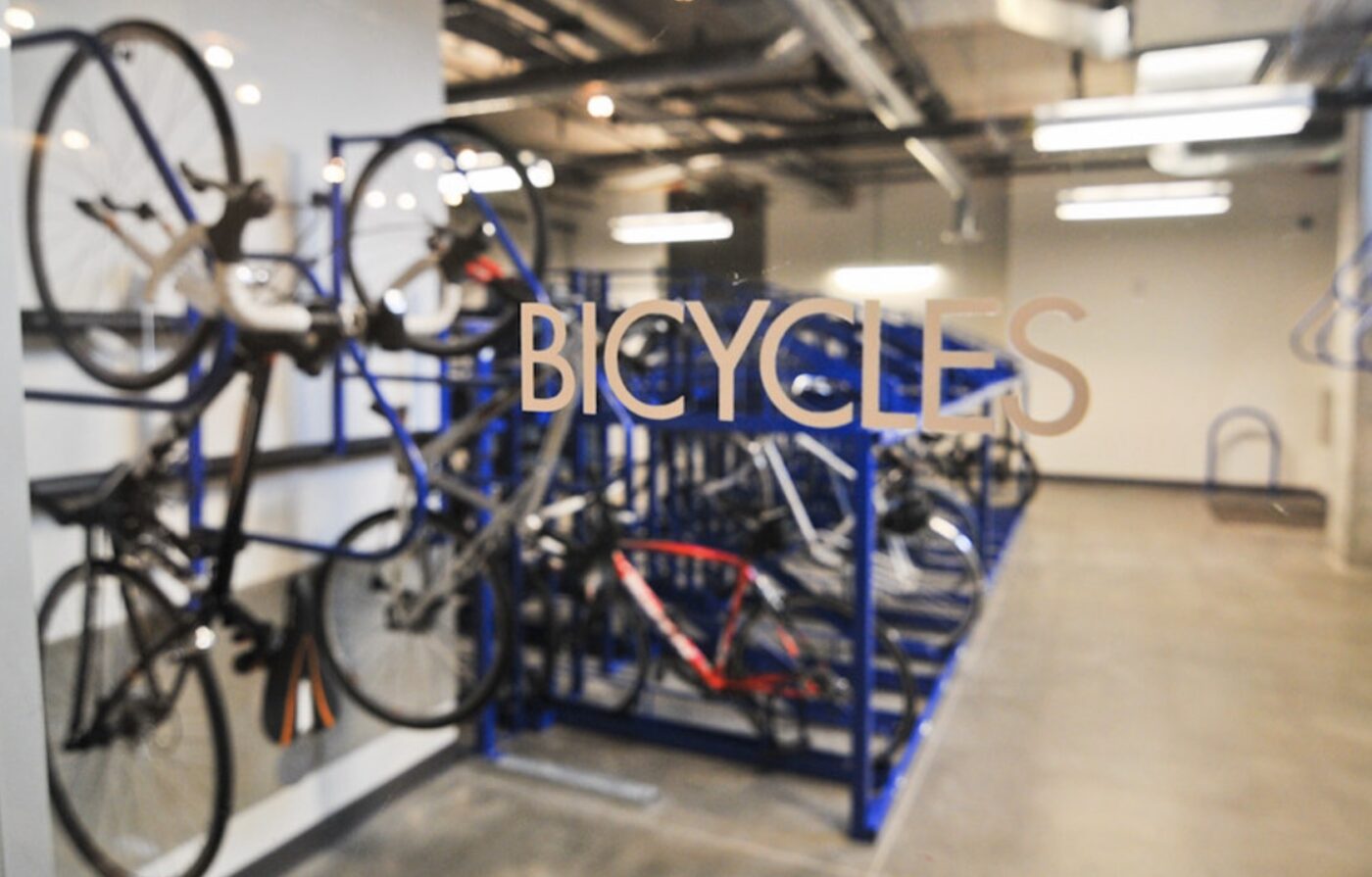
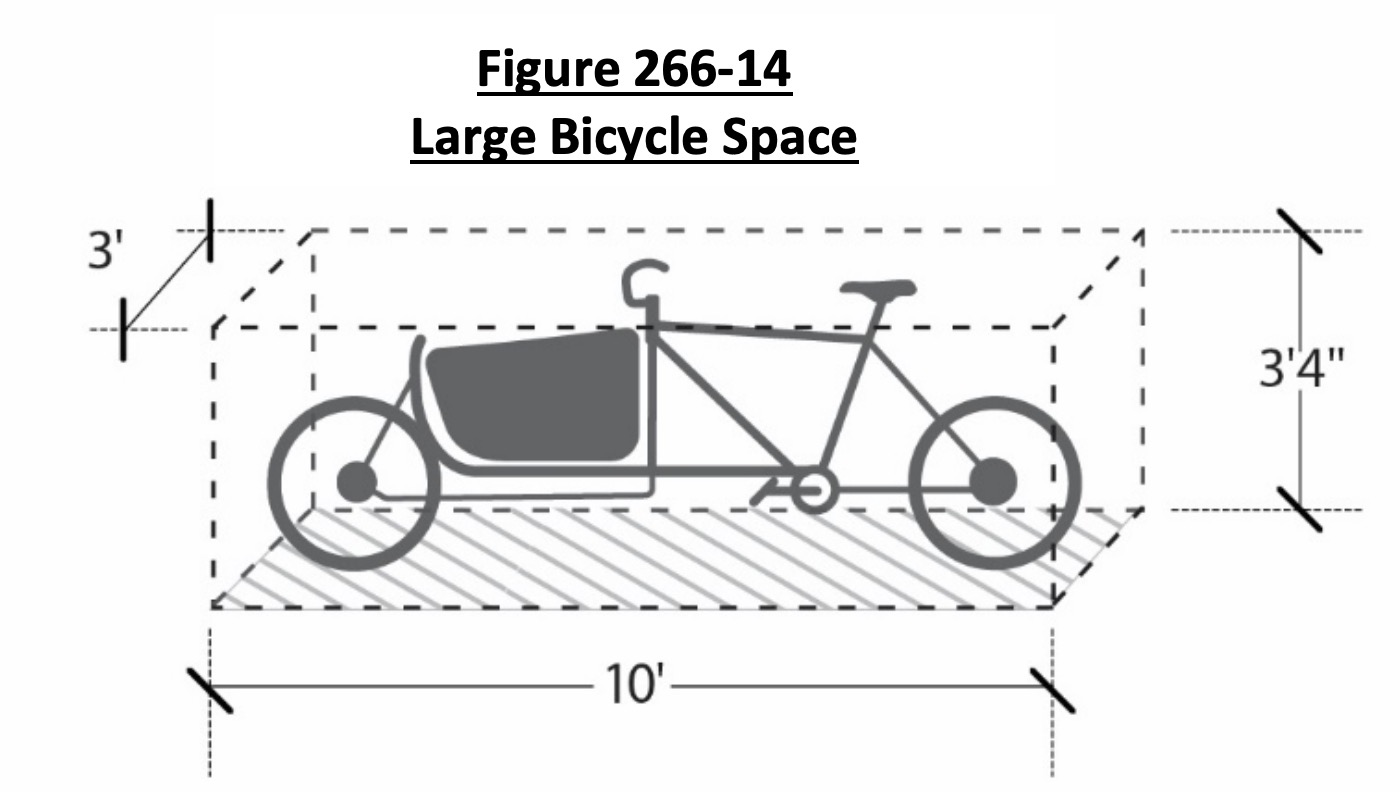
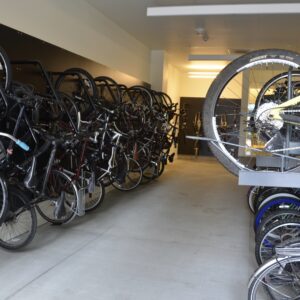

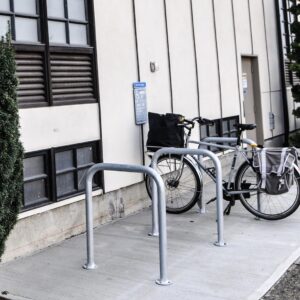

Thanks for reading.
BikePortland has served this community with independent community journalism since 2005. We rely on subscriptions from readers like you to survive. Your financial support is vital in keeping this valuable resource alive and well.
Please subscribe today to strengthen and expand our work.
So a consultant quotes $11k per unit, then when pressed revises it to between $2.6k/unit and $11k/unit. Seems pretty disingenuous to give the highest possible cost in the first place to me, and that is quite a wide range.
And I’ll say it again – it’s incredibly irresponsible for a city commissioner to just ask developers what regulations they want rolled back to decrease construction costs. Doing seemingly no critical analysis on the value of bike parking and just looking at a demonstrably bogus $11k/unit to determine that bike parking regs are onerous is ridiculous. Embarrassing stuff from the city council as usual I guess
You nailed it, blum. I’m waiting for some developer to say that adding windows is too onerous and expensive, and Rubio will agree.
This whole nonsense debate we’re having now really stems from the erroneous framing that the City started with and the ridiculous level of emphasis they are putting on the survey “results.” By asking developers what they thought were the most difficult and costly regulations holding back housing construction, they now are responding as if the survey answers are a mandate. I work in urban planning and let me just say, cities do not always take surveys as the gospel truth! Frankly we planners often ignore the results or just cherry pick the bits that support the overall project recommendations. Which can be less than ideal (very performative public engagement) but also leaves room to balance survey results against all the other aspects of developing project recommendations. Here the City just seems to be saying, “gee, developers said this is onerous so by golly we better remove these requirements!” without a more substantive policy discussion.
If the city staff or outside consultant really took the time to audit all the costs and regulations that go into housing construction, I imagine there would be many factors that contribute to the price and limited supply of new construction and I would bet that bike parking is not the number one obstacle!!! But instead, this survey and the scramble to respond the “results” have all of us in knots talking about whether cargo bike parking or bike alcoves or adjustments to bike parking ratios are a better thing to “sacrifice” in order to jumpstart housing development. The city can amend the bike parking all it wants and I will just sit around and wait for a huge influx in new apartments any day now….
I’d like to know how many car parking spaces are going in these developments where the bike parking is such an expensive impediment to building. I’d be willing to bet money that almost every one of these developments that would like to cut bike parking will still have their car parking spaces.
Most places charge rent for car parking spaces, so they can make back whatever they lose. The current reality today is that car parking is a more important factor in deciding where to live to 90% of folks. I’m not saying that I disagree with you – but that’s the reality of it.
What would stop them from charging rent for bike parking spaces? That’s very valuable to me, I’d totally pay for one just like I’d pay for onsite car parking if that was my mode of transportation.
This will only further the idea that car-free urban living is not for families.
The bigger issue on that front is that 99% of new apartments are studio and 1 bedroom. Even for folks who want to raise their family in a walkable neighborhood, there’s just no housing stock that meets the needs of families.
I think you probably mean studio, 1, and 2 bedrooms. I see ~55 two beds in new builds (built after 2010) available to rent on Zillow, but just 4 3+ beds, only one of which seems to be in an actually new build in a walkable area.
But definitely agree. The lack of family sized apartments is a huge issue, and ties into I think a broader cultural consensus of cities not being a good place to raise a child.
Of all the parts of the bike parking requirements, space for large cargo bikes is like the one thing that people aboslutely must have if they own a cargo bike. Like, there is no alternative. You can’t get those up stairs. Maybe if they have an elevator, maybe. It’s absurd to remove that requirement.
Yep, I sold my car to afford a nice cargo bike and now it’s absolutely essential to my lifestyle. Really sucks that I basically have to rent a house in order to get a garage to park my bike in and therefore can’t afford to live alone if I want to stay car free without significantly impacting my lifestyle and flexibility by giving up my cargo bike. I think the only elevator I could fit my bike in would be a full sized freight elevator, that sounds way more expensive to build than reserving some ground floor space for a cargo bike.
Yeah, I really want to get a bakfiets-style cargo bike, but don’t really have the space, so if I do get an electric assist cargo bike it will probably be something smaller, like a Tern. Removing the cargo bike storage requirement seems to me like it will just force people to make that sort of tradeoff rather than keeping them from buying any cargo bike at all, which…seems fine?
I would also be curious which developments are actually required to have that storage space currently, most of the new construction condos I see are either walk-ups (where any cargo bike would likely be too heavy to carry upstairs) or are smaller and don’t seem like they have the storage space at all.
I’m on the “city went overboard with its 2020 mandates” side of this debate, but have the same worry.
Duong says a cargo bike parking space uses 2/3 the space of a compact auto parking stall once you count aisle space. (It’s not clear to me whether Duong is also counting aisle space for the car.) That raises a question: are any landlords charging for cargo bike spaces? If they could command $20 or $50/month, that’d take the edge off from the builder’s perspective. Maybe in some places they could!
Yesterday, Jonathan illustrated Chris’s guest column with a photo I took for this article I wrote:
https://bikeportland.org/2015/10/15/the-new-lloyd-apartments-bike-parking-is-already-full-maybe-too-full-165888
The point of that article was to point out that when premium bike parking is unmanaged, it tends to fill up with little-used bikes. Same as curbside auto parking. Charging money for the most valuable bike parking spaces is a way of sorting it toward the most frequent bike users. There are other ways to ration it too, like a one-per-household sticker system, but those don’t let you offset the cost that otherwise gets passed in rent to the tenants who don’t own bikes.
The de-prioritization of transportation cycling at PBOT and at city hall continues…
2.5% cycling mode share by 2030!
I’ve never met a bigger bunch of babies than developers. Nothing against babies.
Perhaps it’s a grave mistake to have a bunch of greedy babies managing housing provision in our society.
.
And perhaps we should look at what democratic societies without chronic low-income housing crises do instead (pssst: rent control, right to remain, good cause, and social housing).
Rent control!? That never works!
– the greedy babies
And economists
In OECD democratic nations where rent control is the norm it’s simply not controversial (e.g. the Maoist-communist state of…Germany). And even in the hyper-capitalist USA where Randian freshwater economics dominates, there is increasing support for rent control among economists:
https://peoplesaction.org/wp-content/uploads/2023/07/Academics-Sign-on-Letter_-FHFA-RFI-on-Tenant-Protections-1.pdf
Having recently got a bakfiets cargo bike it’s absolutely a game changer in terms of not having to use a car, it’s also huge and I wouldn’t be able to use it if I had to carry it up stairs. I store mine in a shed.
Future Portland Apartment Residents:
“Oh, I’d love to buy a cargo bike and use it and public transit to go car-free, but since there’s nowhere to park it at my new building, it’s just easier to keep our small car/SUV for running errands.”
We need to build for the future we want, not for the short term interests of today. As the saying goes, “Rome was not built in a day.” If you want 25% mode split, you need a lot of bicycle parking EVERYWHERE, certainly in unit, maybe on the same floor down the hall, definitely underground and at the AMTRAK station, in front of the majority of restaurants, coffee shops and public gathering spaces. buildings need an 8-10′ elevator for cargo bikes. We need the practices and planning rules of Amsterdam, Copenhagen to be here in Portland ASAP
City Hall had no bike parking out front, I believe, the last time I was there. That’s really sad.
I agree with you, Joe, about having lots of bike parking, but can you or anyone else explain why people need such huge cargo bikes? My e-bike is the same size as my regular bike, and I can pull a trailer behind it to get groceries and most other things I need (under 50 lbs). What are people hauling around that they need such cargo capacity? Let me guess: two children?
I really question whether anyone on this website is actually pro-bicycle.
I (my family) need a huge cargo bike because it’s useful. It literally replaces owning a second car (or rather it replaces owning a first car, since it gets far more use than our car does.)
I carry two kids (and their clothes, diapers, water bottles and lunches, and my computer, lunch, etc.) to daycare and work and back every weekday. Kids together are 60 pounds (and growing). I do grocery runs and other errands (with one or more kids) on the weekends.
I own a trailer too. I prefer the huge cargo bike because a bike plus a trailer takes up more room than my huge cargo bike, and its inconvenient to fold up a trailer every single time (at least twice a day) I pack up the kids and their stuff to go somewhere. Locking up a huge cargo bike is also easier than a trailer (do I run an 8′ cable through both wheels?) I also feel a huge cargo bike is easier to maneuver than a bike and trailer.
Even if I wasn’t hauling kids, I might want a huge cargo bike to go to the nursery, or the grocery store, or the pet store, or all three in one trip.
Huge? Huge?! Compared to what? A kayak, a smart car, a sofa, a Christmas tree?
Honestly, these changes seem like a fine compromise to me in the sense that:
Like, in theory it is the case that bike parking requirements would encourage people to ride bikes more, but as far as I know literally every survey about why people do not ride bikes the top concern is safe infrastructure and bicycle storage is not really a big driver there. From my perspective it is fine to take the L here and save advocacy for stuff that is more likely to have an impact.
I’m not disagreeing per se, but people surely have more than one concern when it comes to riding a bike in a city. Not dying from bad infrastructure is obviously going to rank higher than bike storage, but that doesn’t mean we need to only focus on the former to the exclusion of the latter.
Fewer bike parking spaces being built is a net negative for biking in the city, and while these rollbacks aren’t particularly bad in and of themselves (in comparison to how bad a full repeal would have been) they are still bad.
Bike parking is a necessary but not sufficient condition to encourage people to live without a car. I don’t know if you gave a cursory scan to the other comments, but you cannot take a cargo bike up stairs, especially a bakfiets style bike. These bikes are a game changer when it comes to living without a car. With a bakfiets bike, you can actually carry anything you would normally put in your car, actually fully removing the excuse that you need your car for any short errands.
You have to build the parking first, otherwise there won’t be anyone buying the bikes because they have nowhere to put them.
I mean I lived car free for the better part of a decade in an apartment built 100 years before bike parking requirements existed by just leaning my bike against the wall in my apartment, so code mandated bike parking is not actually a necessary condition. It’s also not necessary to have a bakfiets to live car free either!
How many kids did you carry around on your bike? That’s the real question. Is going car free and possibly living in an apartment only for 20 somethings living in a tiny studio, or can families do it? I’m just saying, as a person who does have a kid now (and I live in a detached house), the only way I have to take my three year old anywhere is on a fairly big heavy bike. And if you add in grocery shopping, no way. It’s a big bike doing that.
A Travoy trailer that folds flat can carry a lot of groceries.
I have mixed feelings about this whole situation.
On one hand, if we scale back bike parking requirements, we may be preventing people from making trips by bike in the future. One of the top concerns I hear – anecdotally, I suppose – is that people are afraid their bike will get stolen.
On the other side, if removing some of the more ambiguous requirements gets more housing built in places where people have easy walking access to daily needs and public transit, doesn’t that still feed into a virtuous cycle? A lot of folks live car-free or car-light but never use a bike.
It’s also think there’s some room in the conversation for the possibility of street parking solutions. Some street parking space could be converted into sidewalk-facing lockers of various sizes. Is that feasible or just a pipe dream?
I’ve been mulling over the same idea about on-street bike parking lockers. If cars can use mostly free on-street parking, why not bikes? Let’s put that curb space to good use!
The City and State are forgetting the difference between building things right, and building them right now. These apartments are not just for today, but need to work for the next 50-100 years, when transportation, climate and so many things will be different. The pressure to roll back bike parking, along with (at the state level) wetland protections and other environmental rules, is so short-sighted.
The statement,”Some of these design elements are just challenging for the applicants to configure in the types of floor plans that they’re used to working on.” is so telling; architects aren’t willing to change how they design housing for future needs.
If you look at the code, some of its requirements really are challenging, and way too arbitrary and restrictive. Blaming architects for being unwilling to change isn’t productive.
Here’s why I say that–look at the code section on in-unit bike parking:
These problems jump out immediately to me:
1) “Adjustments and modifications…are prohibited”: That means the City will absolutely not allow a design that strays from these exact requirements, even if it’s comparable or better. A scheme providing double the space, but 16′ away from the entrance instead of 15′ is prohibited. The code allows modifications and adjustments to the most major aspects of projects–height, setback, etc. but not to in-unit bike parking.
2) 15 max from entry door–that’s incredibly restrictive for developing unit plans. And is 16′ so bad it must be prohibited by law? Yes, according to the code.
3) Must be located in a closet or alcove–Why? Many people would prefer NOT to have to maneuver their bike into a closet or alcove. And for people without a bike, many would prefer the extra space be part of a room, so they can use it more flexibly. In several apartments I lived in, I leaned my bike against the wall just inside the unit door. Having that entry area–sometimes a hall, sometimes part of the main room–made wider would be ideal, but that solution isn’t allowed because it would not be a separate alcove or closet.
I could go on–basically the in-unit restrictions are stupidly arbitrary and burdensome, and have nothing to do with creating a useful space for a bike.
I definitely think the changes to the in-unit requirements would be good. When I stored my bike in my apartment, I did what you did and just leaned it against the wall. I also don’t think there needs to be a rack or hook in unit.
For the cargo bikes, one solution might be to calculate the total area needed for standard bike parking, and specifically allocate 5% of that space for cargo bikes. Effectively give them priority of space within a room built for standard bikes.
“Adjustments and modifications…are prohibited”
This may be required because planners tend to grant any adjustment requested, even with the most flimsy of justifications.
If that process actually worked as intended, rulemakers would feel less pressure to include adjustment-free zones for specific policies, and everyone would get better outcomes.
If there are specific designs that are better than what’s called for in code, but technically disallowed for some reason, those should he used to revise the code so that they are allowed, rather than just sweeping all the rules away.
This is nothing different from an oil driller complaining environmental regulations are making oil more expensive. First off, they’re probably not, even if they are making drilling less profitable for you. Secondly, the rules are there for good reasons so just suck it up and follow them.
No, planners do not tend to grant any adjustments requested. They may approve a high percentage after they’ve been filed, but planners often work with applicants before the filing, so that ones that aren’t approvable never make it to actual filing. And the ones that do get approved often have conditions of approval added to the original request.
If there are specific designs that are better than what’s called for in code, but disallowed by the code, those should be approvable through the adjustment process, not just noted as reasons to change the code (which can take years). If those designs are good enough that they justify changing the code, they’re certainly good enough to allow after a careful review on the single project requesting the adjustment.
Granting adjustments does not entail “sweeping all the rules away”. It entails a review that must find that the proposal meets the purpose of the regulation as well as or better than meeting the regulation.
Yes, the rules are there for good reason. But the zoning code (and building codes) typically have processes in place for adjustments and appeals because code writers recognize that they are not all-seeing when they write regulations, and cannot create regulations that are the best for every project and circumstance. Often, the solutions that are approved through adjustments work much better for everyone (not just the owner, but users, neighbors, etc.) than if the regulation was met as written.
We agree that a well-functioning adjustment process is in the best interests of everybody. It sounds like we disagree on how well it functions today, but the concept is sound. The fact that the rulemakers specifically disallow things from being adjusted suggests at least some people who know the system well share my concerns.
I did not mean to suggest that adjustments are sweeping the rules away; I was referring to the larger idea of abandoning things like bike parking requirements (or allowing building on wetlands, etc.).
One reason why the City decided to prohibit adjustments to in-unit bike parking standards could be that nobody’s forced to comply with them. If you don’t like them, you have the option to put all the required bike parking in a common room. That does make them different that things like height or setback standards, that every project that involves creating new space MUST deal with.
That doesn’t change my view that the prohibition against adjustments should be removed, but it does show a hint of logic. It seems like the City may be saying, “It’s not that we don’t think you can come up with in-unit parking that works as well or better than how it would work if you met our standards. It’s that we don’t want to be bothered having to review an adjustment application for it. So either meet our standards, or if you don’t like them, put all the parking in a common room.”
One thing that could be valuable in any review of the standards (maybe it’s been done?) would be to ask tenants in existing buildings whether they park in the common room or in their units, and why. And if they park in their units, do their units have code compliant parking?
I am rather suspicious about the construction costs.
I grew up in learning about construction and design from my architect father. It’s important to identify exactly what costs are associated with the various design decisions. Not all spaces with a building are equal cost. I remember hearing him explain cost cutting measures of clients and his explanations how much or how little various changes would save them.
I hope the report’s preparer got some guidance on building cost values from someone thoroughly familiar with construction.
Also, some spaces, like the corners of parking garages have limited utility for other uses because of design constraints like parking space and drive aisle dimensions.
I hope the report and methodology can be made available. Does anyone know?
In my experience consulting on bike parking structures and facilities in Portland (and across the US)…the design and then installation of bike parking is typically the “last” item on the punch list that architect teams conciser in design and then construction (often too close to occupancy permit deadlines) phases attempts to handle. This then makes bike parking “the problem” for development teams…even for “bike supportive” developers. Some of these design challenges make bike parking consulting “interesting” vs just design teams logging onto “HomeDepot” or “Wayfair” for a basic rack. BUT more often for bike parking rooms it makes installing planned racking and layouts almost impossible as being “the last punch list item” install means that past as built decisions made by other trades (HVAC, electrical, etc.) cascade onto it, such as lowered ceiling heights important for two tier / wall racks or encroach on circulation access to rack spots.
It sounds like you’re saying that with a little bit more thought and planning, much of the difficulty of providing bike parking goes away, and that most of the problem comes from treating it as an afterthought.
“…the design and then installation of bike parking is typically the “last” item…”
Another spot-on comment from Todd.
I love big cargo bikes. I’ve often said, ‘every family needs one’. But guess what? They don’t. Before bakfiet-style bikes were readily available or even heard of, people I know raised all the kids you could fit into their apartment using bike trailers. They aren’t as convenient but you can get them up steps and you can also hang them up in a corner over a drop cloth.
Awkward? Yes. Less safe on the road? Maybe. Here’s a thought: people who decide to have kids now can’t promise those kids a safe and convenient life. I’m not mad at people for having kids, somebody is going to take that challenge.
Some buildings have shared laundry space. They could just as well have shared access to cargo bikes, trailers, all sorts of stuff. Compact electric cars with their own charging space. I know, crazy talk.
Some of what Amsterdam does to accommodate parking bikes. We gotta keep pushing Portland politicians to see and understand the beautiful possibilities for our city.
All these great big projects the narrator talks about in Amsterdam are PUBLIC. But that would not be suitable in the garrison state of the global bourgeoisie, ie, the United States. Pretty soon, you’d have gulags and secret police and dirty commies channeling the spirits of Vladimir Lenin and Joseph Stalin with ouija boards if you allowed such stuff here. Tongue firmly planted in cheek.
On a more serious note, there’s a reason you hear “it doesn’t work” over and over again from private developers. And it’s not necessarily because they are old fashioned boneheads or something. It’s because privately financed projects operate under rigid, short term constraints. You could find the most visionary developer in the world, but if he or she relies on private capital, it will require any investments to pencil out on timelines very different from those imposed by, say, the laws of atmospheric physics and chemistry.
Only publicly financed and built projects can factor in the large risks and long time frames imposed by the greatest challenges facing humanity. No private bank or developer could stay in business and remain solvent if it operated like NASA or NIH, say. What private investor would have given Werner Heisenberg money for his research in the 1920s if he had had to explain to them that, “hey, I’m working on this groovy new theory of matter and energy, which may or may not fundamentally transform all modern science and technology in, oh, maybe the next fifty to hundred years. Hard to say right now”?
And I hasten to add, there’s an even more prohibitive condition to which private projects and private financing are subject: they cannot effectively manage situations in which the benefits and risks are spread highly diffusely across an entire society. The climate crisis being just the most obvious example. But because of the extremist ideology imposed by our capitalist overlords in North America, we are prohibited from planning projects on a completely public basis, meaning that only the extremely blunt instruments of such things as zoning regulations are available to us for the purpose of highly indirectly influencing otherwise “private” enterprise.
You have captured my heartache about my (urban planning) profession and our cities: zoning being an extremely blunt instrument to try to guide private development in a capitalist society beholden to financial institutions and investment rules. I want more tools to shape the cities we dream of!
abject failure of leadership and planning. Portland needs to become more walkable and bike friendly.